Search results for 'Chapter 5: Apply Your Knowledge – Adding Fields, Using Input Mask and Querying Dates (Pages 327 - 328) Use the Babbage CPA'
Maximum words count is 10. In your search query was cut next part: Mask and Querying Dates (Pages 327 - 328) Use the Babbage CPA.
-
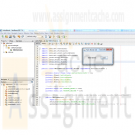
PRG 421 Week 1 Hello World Program
$8.00PRG 421 Week 1 Hello World Program
Learn More
Design, implement, test, and debug a GUI-based version of a “Hello, World!” program.
Create a JFrame that includes a JLabel that reads “Hello, World!” Use a layout manager of your choice.
Include an Exit button to close the program.
Submit the .java source file. -
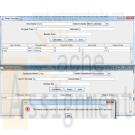
PRG 421 Week 2 GUI Components Program
$20.00PRG 421 Week 2 GUI Components Program
Learn More
For this assignment, you will choose from the following options:
Option 1: Retail Calculator
A retailer would like a calculator to indicate sale prices when he marks items down at various percentages.
Design, implement, test, and debug a GUI application that allows the retailer to enter the item’s name, the item’s original price, and the percentage discounted.
• The application should include a Calculate button that, when pressed, computes and displays the sale price in a label or text field.
• The program should allow the retailer to enter any number of items in this manner.
• Include an Exit button to end the execution of the application.
• The program should allow the user to select a department from a menu. You may create the menu as a true menu, a JComboBox, or radio buttons.
• Create your own list to populate the menu: men’s clothing, women’s clothing, house wares, and so forth.
• Include at least five departments.
• Create a JTextArea or a JTable to display each of the following for each item entered:
o Item name
o Department
o Original price
o Sale price
Option 2: Payroll Application
An employer is looking for an easier way to track employee pay.
Design, implement, test, and debug an application to compute an employee’s weekly pay. If the employee works more than 40 hours a week, the employee earns 1.5 times the basic hourly pay for any time worked over 40 hours. The program should allow the user to input the employee’s name, the number of hours worked, and the hourly rate.
• The application should include a Calculate button that, when pressed, computes and displays the total pay in a label or text field.
• The program should allow the user to enter information for any number of employees in this manner.
• Include an Exit button to end the execution of the application.
• The program should allow the user to select the employee’s department from a menu. This can be a standard menu, radio buttons, or a JComboBox.
• Create your own list to populate the menu: Marketing, IT, Accounting, and so forth.
• Include at least five departments.
• Validate the employee’s hourly wage and hours worked according to the following rules:
The hourly wage must be at least $6 per hour and cannot be more than $150 per hour. It must be numeric.
The hours worked must be a numeric value greater than or equal to 0 and cannot be greater than 60.
• Create a JTextArea, JTable, or other form of a table to your application and use that to list the following for every employee:
o Name
o Department
o Weekly salary
Add each employee to the list after you have computed that employee’s salary. -

PRG 421 Week 4 Pie Chart Applet
$15.00PRG 421 Week 4 Pie Chart Applet
Learn More
Write an applet that includes a pie chart.
Use a news article with statistics that are good candidates for a pie chart: for example, political candidate preferences; percentages of those for, against, or undecided about a ballot measure; and so forth.
Cite the source for your input statistics.
Submit the applet along with an HTML file to launch it. -
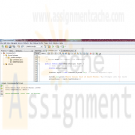
PRG 420 Week 2 Simple Commission Calculation Program Part 1
$15.00PRG 420 Week 2 Simple Commission Calculation Program Part 1
Learn More
Write a Java™ application using NetBeans™ Integrated Development Environment (IDE) that calculates the total annual compensation of a salesperson. Either a GUI graphic user interface) program or non-GUI program is acceptable. Consider the following factors:
• A salesperson will earn a fixed annual salary of $25,000.00.
• A salesperson will also receive a commission as a sales incentive. Commission is a percentage of the salesperson’s annual sales. The current commission is 10% of total sales.
• The total annual compensation is the fixed salary plus the commission earned.
The Java™ application should meet these technical requirements:
Create a NetBeans project and name it XXXIA2. XXX is your last name. It is important to use your last name so that each student’s project name is unique. When your team evaluation the members’ program, the team will know whom the program belong to. Your system can also load in multiple projects without conflicting project names. The number 2 in the file name is the academic week number.
• The application should have at least one class, in addition to the application’s controlling class (a controlling class is where the main function resides).
• There should be proper documentation in the source code.
• The application should ask the user to enter annual sales, and it should display the total annual compensation.
Because NetBeans produces multiple files for one project, the best method to submit an assignment is to zip the files. There should be one project folder created by NetBeans using your project name. Zip the folder. Submit your NetBeans project zip file. -

PRG 420 Week 3 Simple Commission Calculation Program Part 2
$15.00PRG 420 Week 3 Simple Commission Calculation Program Part 2
Learn More
Modify the Week Two Java™ application using Java™ NetBeans™ IDE to meet these additional and changed business requirements. Either a GUI (graphic user interface) program or non-GUI program is acceptable.
• The company has recently changed its total annual compensation policy to improve sales.
• A salesperson will continue to earn a fixed salary of $25,000.00. The current sales target for every salesperson is $120,000.
• The sales incentive will only start when 80% of the sales target is met. The current commission is 10% of total sales.
• If a salesperson exceeds the sales target, the commission will increase based on an acceleration factor. The acceleration factor is 1.25 which means all sales above the sales target will be earning 25% commission.
• The application should ask the user to enter annual sales, and it should display the total annual compensation.
• The application should also display a table of potential total annual compensation that the salesperson could have earned, in $5000 increments above the salesperson’s annual sales, until it reaches 50% above the salesperson’s annual sales.
Sample Table: Assuming a total annual sales of $100,000, the table would look like this:
Total Sales Total Compensation
100,000 <<Program calculated value>>
105,000 <<Program calculated value>>
110,000 <<Program calculated value>>
115,000 <<Program calculated value>>
120,000 <<Program calculated value>>
125,000 <<Program calculated value>>
130,000 <<Program calculated value>>
135,000 <<Program calculated value>>
140,000 <<Program calculated value>>
145,000 <<Program calculated value>>
150,000 <<Program calculated value>>
The Java™ application should also meet these technical requirements:
Create a NetBeans project and name it XXXIA3. XXX is your last name. It is important to use your last name so that each student’s project name is unique. When your team evaluation the members’ program, the team will know whom the program belong to. Your system can also load in multiple projects without conflicting project names. The number 3 in the file name is the academic week number.
• The application should have at least one class, in addition to the application’s controlling class.
• The source code must demonstrate the use of conditional and looping structures.
• There should be proper documentation in the source code.
Because NetBeans produces multiple files for one project, the best method to submit an assignment is to zip the files. There should be one project folder created by NetBeans using your project name. Zip the folder. Submit your NetBeans project zip file. -

PRG 420 Week 4 Simple Commission Calculation Program Part 3
$15.00PRG 420 Week 4 Simple Commission Calculation Program Part 3
Learn More
Modify the Week Three Java™ application using Java™ NetBeans™ IDE to meet these additional and changed business requirements. Either a GUI (graphic user interface) program or non-GUI program is acceptable.
• The application will now compare the total annual compensation of at least two salespersons.
• It will calculate the additional amount of sales that each salesperson must achieve to match or exceed the higher of the two earners.
• The application should ask for the name of each salesperson being compared.
The Java™ application should also meet these technical requirements:
Create a NetBeans project and name it XXXIA4. XXX is your last name. It is important to use your last name so that each student’s project name is unique. When your team evaluation the members’ program, the team will know whom the program belong to. Your system can also load in multiple projects without conflicting project names. The number 4 in the file name is the academic week number.
• The application should have at least one class, in addition to the application’s controlling class.
• The source code must demonstrate the use of Array or ArrayList.
• There should be proper documentation in the source code.
Because NetBeans produces multiple files for one project, the best method to submit an assignment is to zip the files. There should be one project folder created by NetBeans using your project name. Zip the folder. Submit your NetBeans project zip file. -
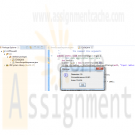
CIS355A iLab 1 ShowEscapeSequences Circle and PracticeArithmeticOperators Programs
$15.00CIS355A iLab 1 ShowEscapeSequences Circle and PracticeArithmeticOperators Programs
In this lab you will learn how to use the Java Software Development Kit (SDK) with the Eclipse programming tool. In addition, you will create three simple Java programs.
Deliverables
Program files for each of the following three programs.
1. ShowEscapeSequences.java
2. Circle.java
3. PracticeArithmeticOperators.java
At the beginning of ALL your programs, put a comment box that includes the program name, your name, and a brief description of the program.iLAB STEPS
STEP 1: ShowEscapeSequences (10 points)
Write a Java program named ShowEscapeSequences.java that displays the following.
I really like
CIS355A
"Business Application Programming with Lab using JAVA"STEP 2: Circle (15 points)
Write an application called Circle.java that inputs from the user the radius of a circle as an integer and prints the circle’s diameter, circumference, and area. Use the example program and GUI technique message dialog box shown in the Week 1 Lecture.
Use the following formulas.
diameter = 2 * radius
circumference = 2 * Math.PI * radius
area = Math.PI * radius * radius
Use the predefined constant Math.PI for your calculation. This constant is more precise than the value 3.14159. Class Math is defined in the java.lang package so you do not need to import it.STEP 3: PracticeArithmeticOperators (15 points)
Learn More
Write an application called PracticeArithmeticOperators.java that asks the user to enter two numbers. The program is to convert these numbers from String to type int and then print in a tabular format the sum, the difference, the product, and the quotient of the two numbers entered. Use the example program shown in the Week 1 Lecture. For example, if the user enters 25 and 5, the following should be displayed.
Operation Result
25 + 5 30
25 – 5 20
25 * 5 125
25 / 5 5 -
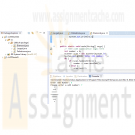
CIS355A iLab 2 Largest Palindrome and Diamond Programs
$15.00CIS355A iLab 2 Largest Palindrome and Diamond Programs
In this lab you will create programs that use control structures and user-defined methods.
Deliverables
Program files for each of the following three programs.
1. Largest
2. Palindrome
3. Diamond
At the beginning of ALL your programs, put a comment box that includes the program name, your name, and a brief description of the program.iLAB STEPS
STEP 1: Largest (10 points)
Write a Java application program called Largest.java that inputs a series of 10 single-digit numbers and determines and prints the largest of the numbers. Except main() method, no other user-defined method is required. Your program should use at least the following three variables
1. counter: A counter to count to 10 (that is, to keep track of how many numbers have been input and to determine when all 10 numbers have been processed);
2. number: The current digit input to the program; and
3. largest: The largest number found so far.
When each number is entered, make sure it is a single digit number, that is 0 to 9.STEP 2: Palindrome (15 points)
A palindrome is a sequence of characters that reads the same backward as forward. For example, each of the following five-digit integers is a palindrome: 12321, 55555, 45554, and 11611. Write an application called Palindrome.java that asks the user to enter in a five-digit integer and determines whether it is a palindrome. If the number is not five digits long, display an error message dialog indicating the problem to the user. When the user dismisses the error dialog, allow the user to enter a new value.
Your program will have the following four methods
1. main() method, which controls the execution of the program;
2. retrieveInput() method, which prompts and retrieves the input values;
3. check() method, which determines whether it is a palindrome; and
4. display() method, which displays the result.STEP 3: Diamond (15 points)
Learn More
Write a program called Diamond.java that uses a method diamondOfAsterisks() that displays a diamond (the row number of a diamond must be odd) of asterisks whose row is specified in an integer parameter row. For example, if the user enters a 7, then the diamond will have seven rows and the method will display the pattern of asterisks. Below is an example of the diamond displayed when 7 is entered.
*
***
*****
*******
*****
***
* -
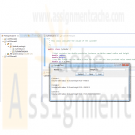
CIS355A iLab 3 Cylinder and Date Java Programs
$15.00CIS355A iLab 3 Cylinder and Date Java Programs
In This lab you will create two programs that use classes and methods.
Deliverables
Program files for each of the following two programs
1. Cylinder
2. DateiLAB STEPS
STEP 1: Cylinder
Create a class called Cylinder.java that contains two double-precision instance variables named radius and height. The class should include a constructor that initializes the radius and height variables. Also, you need a class method named volume() that returns the volume of a Cylinder object. The volume of a cylinder is given by its radius squared times its height times Pi (radius * radius * height * Math.PI). You can either use the value 3.1416 for Pi or use the Java provided value named Math.PI.
Write a class called CylinderTest.java and declare an array of three Cylinder objects to call the methods you declared in the Cylinder class. Make sure that all class methods are called from main(). Have main() display the value returned by volume() and verify the returned value by hand calculations (paper/pencil). Prompt the user to enter the values for the radius and height of each Cylinder object in the array.
Learn More
STEP 2: Date (20 points)
Create a program called Date.java to perform error-checking on the initial values, for instance: fields month, day, and year. Also, provide a method nextDay() to increment the day by one. The Date object should always remain in a consistent state.
Write a program called DateTest.java that prompts the user to enter the month, day, and year as numeric values. This program then creates a Date object using the Date class you just created and tests the nextDay() method. This can be done in a loop of 40 iterations: the Date object calls the nextDay() method and prints the date during each iteration of the loop. This loop is to illustrate that the nextDay() method works correctly. Test the following cases:
a. Incrementing into the next month, for example, use date: 02/28/2011
b. Incrementing into the next year, for example, use date: 11/27/2011
c. Incrementing into the next month in a leap year, for example, use date: 02/28/2012
Sample Program Output:
Checking increment
Date object constructor for date 11/27/2011
Incremented Date:11/28/2011
Incremented Date:11/29/2011
Incremented Date:11/30/2011
Day 31 invalid. Set to day 1.
Incremented Date:12/1/2011
Incremented Date:12/2/2011
...
Incremented Date:12/30/2011
Incremented Date:12/31/2011
Day 32 invalid. Set to day 1.
Incremented Date:1/1/2012
Incremented Date:1/2/2012
Incremented Date:1/3/2012
Incremented Date:1/4/2012
Incremented Date:1/5/2012
Incremented Date:1/6/2012 -
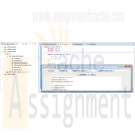
CIS355A iLab 4 InheritanceTest DayGui and OfficeAreaCalculator Java Programs
$15.00CIS355A iLab 4 InheritanceTest DayGui and OfficeAreaCalculator Java Programs
In this lab, you will create one project that uses inheritance and two simple Graphical User Interfaces (GUI) programs.
Deliverables
Program files for each of the following three programs
1. InheritanceTest
2. DayGui
3. OfficeAreaCalculatoriLAB STEPS
STEP 1: InheritanceTest (20 points)
Write a program called InheritanceTest.java to support an inheritance hierarchy for class Point-Square-Cube. Use Point as the superclass of the hierarchy. Specify the instance variables and methods for each class. The private variable of Point should be the x-y coordinates. The private data of Square should be the sideLength. The private data of Cube should be depth. Each class must provide applicable accessor, mutator, and toString() methods for manipulating private variables of each corresponding class. In addition, the Square class must provide the area() and perimeter() methods. The Cube must provide the area() and volume() methods.
Write a program that instantiates objects of your classes, ask the user to enter the value for x, y, and sideLength, test all instance methods and outputs of each object’s perimeter, area, and volume when appropriate.STEP 2: DayGui (10 points)
Write a program called DayGui.java that creates a GUI having the following properties
Object Property Setting
JFrame Name Caption Layout mainFrame Messages FlowLayout
JButton Name Caption Mnemonic cmdGood Good G
JButton Name Caption Mnemonic cmdBad Bad B
Add individual event handlers to your program so that when a user clicks the Good button, the message "Today is a good day!" appears in a dialog box, and when the Bad button is clicked, the message "I'm having a bad day today!" is displayed. The following tutorial shows you much of the code solution. Feel free to use the tutorial, but make changes so that you are not simply copying the tutorial code for your entire solution. To make this different from the tutorial, change the colors of the buttons and panel. Also, add this application to a tabbed pane along with the program you will complete in the next step, Step 3. The following tutorials will likely be useful as you work to complete this step:
• JTabbedPane
• Tutorial to Write Your First GUISTEP 3: OfficeAreaCalculator (10 points)
Learn More
Write a program called OfficeAreaCalculator.java that displays the following prompts using two label components
• Enter the length of the office:
• Enter the width of the office:
Have your program accept the user input in two text fields. When a button is clicked, your program should calculate the area of the office and display the area in a text field with a label of Area. This display should be cleared whenever the input text fields receive the focus. A second button should be provided to terminate the application (Exit button).
The following tutorial shows you much of the code solution. Feel free to use the tutorial, but make changes so that you are not simply copying the tutorial code for your entire solution. To make this different from the tutorial, change the colors of the panel. Also, add this application to the same tabbed pane (see the JTabbedPane tutorial) as the application you built in Step 2, the DayGui application.
• Office Area Calculator Tutorial




